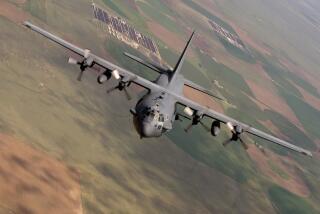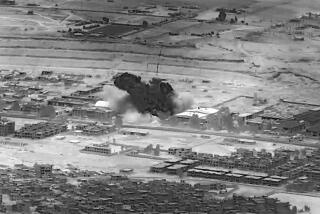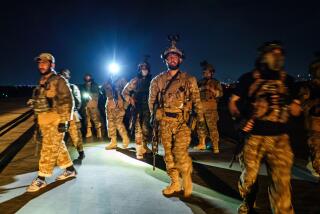Afghan Troops Are Next Target
- Share via
WASHINGTON — The U.S.-led air campaign in Afghanistan appears destined to quickly become a hunt for ground troops and their equipment, a tough and risky job that nevertheless could prove key to efforts to weaken or topple the country’s Taliban regime.
In its first two days, the campaign has been focused on destroying large strategic targets, such as command headquarters and air defense sites. Yet the attacks also have been aimed at some ground forces, U.S. officials acknowledge. And with the relative lack of larger targets, experts predict that U.S. forces soon will have little choice but to shift their emphasis toward a pursuit of Taliban troops and their tanks, artillery, personnel carriers and trucks.
The Taliban’s ground forces afford the United States an important point of pressure, because they are vital to the extremist Islamic regime’s efforts to maintain control over a restive population.
The ground troops “are the most important element of their control,” said Kenneth M. Pollack, a Middle East expert at the Council on Foreign Relations, an independent policy group. “They are what the Taliban holds dear.”
In public comments, Defense Secretary Donald H. Rumsfeld and other U.S. officials have said that some Taliban forces have already been targeted. On Sunday, for example, the raids struck a concentration of tanks and trucks in the key northern city of Mazar-i-Sharif, where the Taliban has long arrayed troops to hold off the opposition force called the Northern Alliance.
Given the small number of bigger targets in the war-ravaged nation, “I don’t see how you can avoid going after them, and pretty quickly,” said former defense official Daniel Goure, now an analyst at the Lexington Institute.
The Taliban is believed to have about 50,000 troops. Of that number, more than 10,000 are believed to be associated with the Al Qaeda network of Osama bin Laden, who is suspected of being the mastermind of the Sept. 11 terrorist attacks on New York and the Pentagon. Finding Bin Laden--and wiping out his network--is an explicit goal of the U.S.-led campaign.
The Taliban is believed to have fewer than 1,000 aging Russian-made tanks, and a few dozen armored personnel carriers.
Most recent U.S. air campaigns have started by concentrating on key strategic targets, then shifted to smaller, mobile field forces.
The 1999 U.S.-led air campaign against the Yugoslav government to end its brutal crackdown in Kosovo demonstrated how tough a task this can be.
After weeks of bombing, allied warplanes had struck all the strategic targets they needed to hit and began hitting the forces that were patrolling Kosovo, a province of Serbia, Yugoslavia’s dominant republic.
Although the allied forces conducted hundreds of fighter-jet sorties, the Serbs had success in eluding the attacks. They learned to hide their armored vehicles in forests or buildings, to move at night and to throw off their pursuers through such means as disguising destroyed tanks as working ones.
The Kosovo war also revealed some of the risks involved in having pilots pursue small groups of ground forces and equipment. As they sought to pick out targets from high altitudes, pilots made mistakes that resulted in civilian deaths.
In one highly publicized case, they bombed a collection of broken-down farm trucks driven by refugees that they took for a military convoy; in another case, they struck a bridge, not noticing that a half-full passenger train was traveling on it.
Such civilian casualties led to public relations problems. In Afghanistan, minimizing casualties may be even more crucial, given the need to avoid inflaming public opinion in other Muslim countries.
Gen. Richard B. Myers, chairman of the Joint Chiefs of Staff, acknowledged Monday that U.S. pilots have already been operating under the rules of engagement they need to go after troops and mobile targets.
U.S. officials have sought to remain vague about the extent to which they intend to work militarily with the Northern Alliance. That’s because Pakistan, an important U.S. ally in the fight, opposes the idea of a new Afghan government led by the rebel group. But it is clear that U.S. forces could put strong military pressure on the Taliban by working with the Northern Alliance.
If U.S. forces began giving air cover to the alliance, they would strengthen the momentum of the rebels, who have been bogged down in fighting for several years. That would force a tough choice on the Taliban: The regime could either concentrate forces in a way that would make them a tempting target for U.S. strikes, or they could disperse--possibly clearing the way for a rebel advance.
More to Read
Sign up for Essential California
The most important California stories and recommendations in your inbox every morning.
You may occasionally receive promotional content from the Los Angeles Times.











